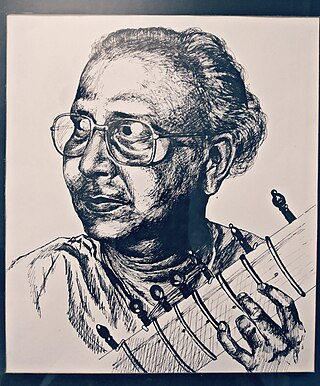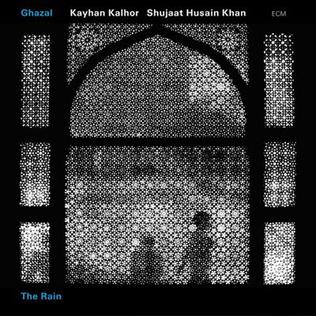The music of Iran encompasses music that is produced by Iranian artists. In addition to the traditional folk and classical genres, it also includes pop and internationally celebrated styles such as jazz, rock, and hip hop.
Persian traditional music or Iranian traditional music, also known as Persian classical music or Iranian classical music, refers to the classical music of Iran. It consists of characteristics developed through the country's classical, medieval, and contemporary eras. It also influenced areas and regions that are considered part of Greater Iran.

Qawwali is a form of Sufi Islamic devotional singing originating in South Asia. Originally performed at Sufi shrines or dargahs throughout South Asia, it is famous throughout Pakistan, India, Bangladesh and Afghanistan and has also gained mainstream popularity and an international audience as of the late 20th century.

The kamancheh is an Iranian bowed string instrument used in Persian, Azerbaijani, Armenian, Kurdish, Georgian, Turkmen, and Uzbek music with slight variations in the structure of the instrument. The kamancheh is related to the rebab which is the historical ancestor of the kamancheh and the bowed Byzantine lyra. The strings are played with a variable-tension bow.

Kayhan Kalhor is an Iranian Kurdish kamancheh and setar player, and a vocal composer. He has received three Grammy Award for Best Traditional World Music Album nominations. Kalhor also has earned two nominations and won one Grammy Award for Best Global Music Album as a member of the Silk Road Ensemble.

Pandit Nikhil Ranjan Banerjee was an Indian classical sitarist of the Maihar Gharana. Along with Pandit Ravi Shankar and Ustad Vilayat Khan, he emerged as one of the leading exponents of the sitar. He was a recipient of the Indian civilian honour of the Padma Bhushan.

The classical music of Afghanistan is called klasik, which includes both instrumental and vocal forms (ghazals). Many ustad, or professional musicians, are descended from Indian artists who emigrated to the royal court in Kabul in the 1860s upon the invitation of Amir Sher Ali Khan.

A setar is a stringed instrument, a type of lute used in Persian traditional music, played solo or accompanying voice. It is a member of the tanbur family of long-necked lutes with a range of more than two and a half octaves. Originally a three stringed instrument, a fourth string was added by Mushtaq Ali Shah by the mid 19th century. It is played with the index finger of the right hand.
Ghazal is a band formed by Kurdish-Iranian kamencheh player Kayhan Kalhor, Indian sitarist Shujaat Khan, and Indian tabla player Swapan Chaudhuri. Together, they perform music blending North Indian and Persian classical and light classical traditions.

Shujaat Husain Khan is one of the most acclaimed North Indian musicians and sitar players of his generation. He belongs to the Imdadkhani gharana school of music. He has recorded over 100 albums and was nominated for a Grammy Award for Best World Music Album for his work with the band Ghazal with Iranian musician Kayhan Kalhor. He also sings frequently. His style of sitar playing, known as gayaki ang, is imitative of the subtleties of the human voice.
The history of the sitar in jazz, that is the fusion of the sounds of Indian classical music with Western jazz, dates back from the late-1950s or early-1960s when musicians trained in Indian classical music such as Ravi Shankar started collaborating with jazz musicians such as Tony Scott and Bud Shank. Later jazz recordings containing sitar music include albums by Miles Davis, Alice Coltrane, Yusef Lateef, Joe Harriott ,and Ornette Coleman.
Chhaap Tilak Sab Chheeni, is a Ghazal written and composed by Amir Khusro, a 14th-century Sufi mystic, in popular Western Indian language Braj Bhasha. Due to the resonance of its melody and mystical lyrics, it is frequently heard in Qawwali concerts across Indian Subcontinent. Chaapp Tilak Sab Chheeni is considered as Amir Khusru‘s most known Kalam which is basically a penned version of his imagination of devotion and the joy of oneness with the eternal one. This poetry is an epic example where an inherent middle eastern art form gets entangled with the Indic philology, custom and art a unique twist between the two artforms. This kind of devotion is rarely seen in Islamic ghazals and qawwalis preceding it. This poetry is a great example of the role both cultures played to create this Ghazal and Qawwali which has a unique essence combining both Indic and Islamic culture which inherently created a new unique art form which contributed to the early beginnings of the Ganga-Jamuni Tehzeeb culture to be developed.

Sandeep Das is an Indian tabla player and composer currently based in Boston, Massachusetts, United States.

The Wind is an album by Iranian kamancheh player Kayhan Kalhor and Turkish bağlama player Erdal Erzincan, recorded in Istanbul in November 2004, mixed at Rainbow Studio in Oslo in 2006 and released on ECM in September later that year. It was their first collaborative album and the result is a set of instrumental compositions that flow into each other like one continuous work.

Silent City is an album by New York City-based string quartet, Brooklyn Rider and Iranian musician Kayhan Kalhor, released by World Village Records in 2008.

Scattering Stars Like Dust is a solo album by Iranian musician Kayhan Kalhor, released on 9 June 1998 in the United States through Traditional Crossroads records.

Kula Kulluk Yakişir Mi is a live album by Turkish Musician Erdal Erzincan and Iranian Kamancheh player Kayhan Kalhor, released through ECM Records on 27 August 2013 in the United States.

Beyond Any Form is a collaborative studio album by Persian traditional musicians Homayoun Shajarian and Tahmoures Pournazeri, as vocalist and composer respectively.

Masters of Persian Music is a Persian classical music ensemble founded in 2000 by four internationally recognized ustāds (masters) of the genre: vocalist Mohammad-Reza Shajarian; composer-musicians Hossein Alizâdeh and Kayhan Kalhor; and Mr. Shajarian's son, multi-instrumentalist singer Homayoun Shajarian.

The Rain is a live album by the Persian-Indian hybrid ensemble Ghazal, comprising kamancheh player Kayhan Kalhor vocalist and sitar player Shujaat Husain Khan, and tabla player Sandeep Das, recorded at a live concert at Radio Studio DRS in Bern on May 28, 2001 and released on ECM in August 2003. The album was nominated for a Grammy Award for Best Traditional World Music Album in 2004.














